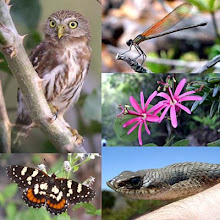September
10, 2015
I’m in
Bolivia for the first time in five years. In the previous eleven years I had
averaged one trip per year, and so this has been the longest I’ve been away
from this amazing country since 2000.
I’ve always
wanted to check out the Apa Apa Reserve, a private patch of foothill cloud
forest famous for its frequent reports of the nearly mythical Scimitar-winged
Piha, among others. I only knew it
was somewhere down the east slope of the Andes below La Paz, but never had
really looked into specifics. When it came time for the WINGS office to buy my
air ticket for the Bolivia tour this year, I just requested to go two days
early, with a first stop in La Paz, rather than going directly to Santa Cruz.
It turned out that two of the tour’s participants were also going early, also
going to La Paz, and didn’t know what they were going to do there. So I invited
Bill and Mabel to join me for the short exploratory trip. At the very least it
I thought it would be good to share the costs of the transportation.
Apa Apa
turns out to be a four-hour drive from La Paz, up and over the pass towards the
famous “Death Road” that leads to Coroico, but turning off towards Chulumani
before you get there. The scenery is wonderful.
We passed
this very out-of-place castle-like building, apparently once a restaurant, and now
in the process of being remodeled.
We entered a
semi-dry valley in a rain shadow, and I had to make one quick roadside stop
when I saw these blooming Hippeastrum sp.,
a native species of what one would call an “amaryllis” in the North American
garden trade.
We finally
got to Apa Apa in the mid-afternoon for our first birding. Much of the reserve
is accessible along a very narrow two-track road that leads to a distant
village.
Amazingly,
the first bird we actually saw was this Black-and-chestnut Eagle. I’d only seen
this a couple of times in SE Peru before and never in Bolivia.
From here you
can look down onto the town of Chulumani, the largest town in the area, and
where we would spend the two nights in two different hotels.
We returned
here two more times, the next two mornings, with an afternoon exploring the
private reserve above the owners’ hotel (which is also being remodeled).
One of the
commonest birds here, and the most likely candidate to respond to pishing is
the endemic Bolivian Brush-Finch.
This male
Booted Racket-tail was perched amazingly close to me. There are no feeders here
(or anywhere else in Bolivia, as far as I can determine), so there’s a niche
waiting to be exploited.
I’ve seen a
similar Bejaria sp. as this one at
the Acjanaco Pass in SE Peru. It doesn’t look like it at first glance, but it’s
a member of the Ericaceae family, though it does have a vague resemblance to an
azalea, genus Rhododendron.
I was amazed
by this bright yellow skipper and had little difficulty finding a name for this
distinctive creature: Falga farina.
It’s probably endemic to Bolivia, if not this valley.
This tiger
moth, Pantherodes unciaria, was at
our hotel in Chulumani. It’s an amazingly widespread species; I’ve seen it in
northern Mexico and Costa Rica as well.
I’ve seen
this satyr, Parataygetis albinotata,
only once before, and that was in Bolivia.
I turned
over a rock to find this sleeping toad. I might have gone unidentified, except
for the Guía Fotografica del los Anfibios
de la Región de los Yungas, Bolivia by Mauricio Pacheco Suarez, which just
appeared as a downloadable pdf, covering this precise region. It appears to be Rhinella leptoscelis, with a
distinctively rounded snout; a discrete, round paratoid gland; and a row of
hard, conical warts down the side.
On our way
back to La Paz we had a little time to bird the upper elevation cloud forests
before we had to turn the car in and for my evening flight to Santa Cruz. Our
best find was a scarce Sharp-tailed Streamcreeper, which I recognized from its
call, and then brought in for us to see with iPod. The previous ones I had seen
in Bolivia were along streams with mossy boulders, but here’s a view of the
simple culvert where this bird was living.
A nice mixed
flock came through, with Buff-banded Tyrannulets, Saffron-crowned Tanagers, and
many others, but only this Blue-capped Tanager sat still enough for photos.
On my way to
the airport, I took this photo of the stunningly beautiful Illimani volcano from
the highway leading out of the La Paz canyon. The aerial tram is a new tourist
attraction built since I was last in La Paz.





















mail of Apa Apa, please????
ReplyDeleteI dont speak english, sorry
Enrique, enb306@hotmail.com